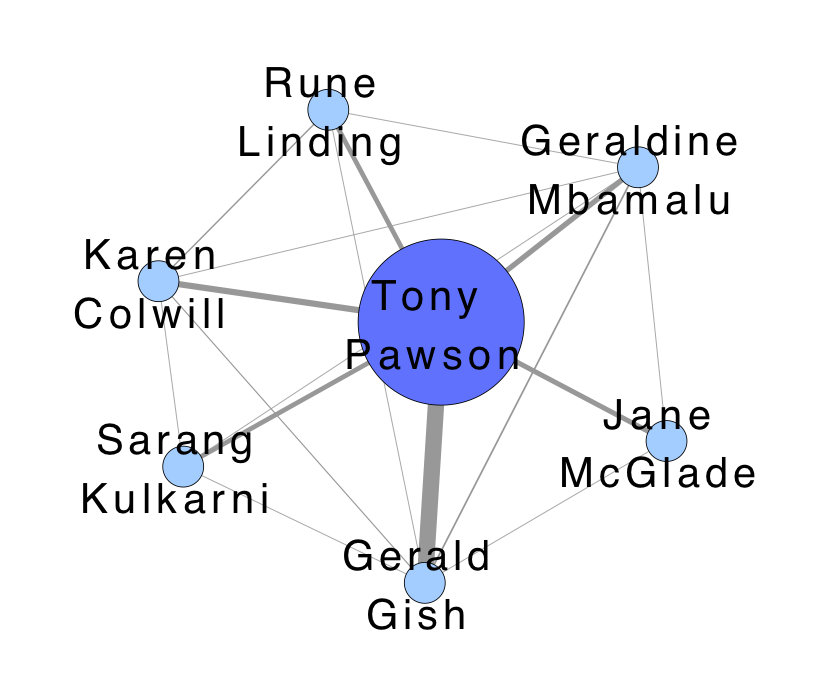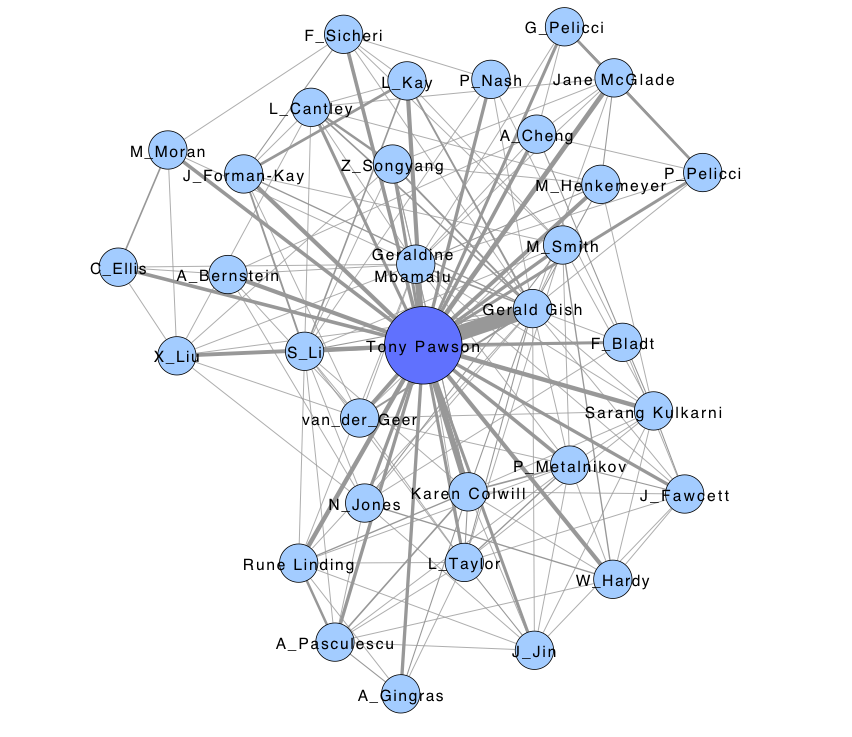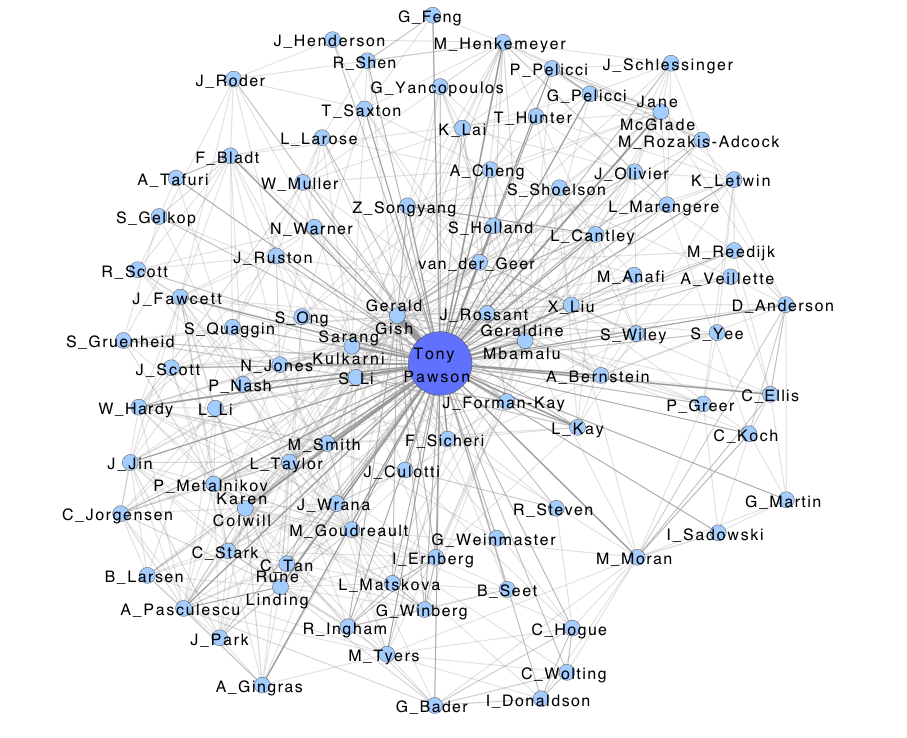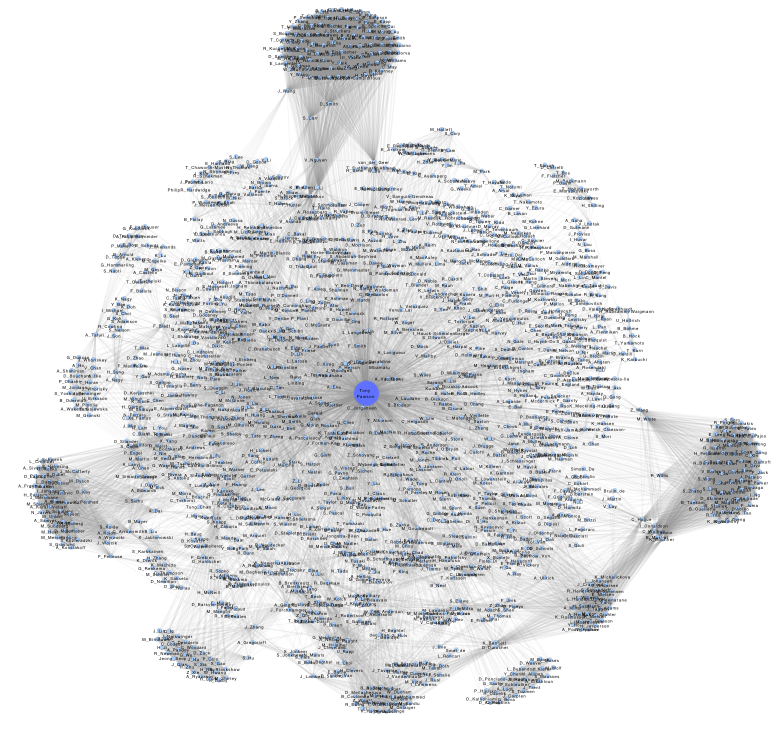|
Size: 5478
Comment:
|
Size: 6050
Comment: Added example files to get started page
|
| Deletions are marked like this. | Additions are marked like this. |
| Line 3: | Line 3: |
| {{attachment:UserguideSocialNetworkApp/socialNetwork_logo.png|Social Network Logo|align="right"}} <<BR>> <<BR>> <<BR>> <<BR>> == Social Network App Download Page == |
{{attachment:UserguideSocialNetworkApp/socialNetwork_logo.png|Social Network Logo|align="right"}} <<BR>> <<BR>> <<BR>> = Social Network App Download Page = |
| Line 9: | Line 9: |
| The Social Network Cytoscape app creates a visual summary of how individuals are connected. Biological networks can be visualized and analyzed using Cytoscape. Often researchers want to go beyond the network of proteins or genes and also look at the inter-connectedness between colleagues and institutions. Who tends to publish together? What institutions are most collaborative? Are there inter-disciplinary connections in my institution? The app addresses these questions by building co-publication networks where the nodes represent authors and edges represent the publications that different authors share. | The Social Network Cytoscape app creates a visual summary of how individuals are connected. Biological networks can be visualized and analyzed using Cytoscape. Often researchers want to go beyond the network of proteins or genes and also look at the inter-connectedness between colleagues and institutions. Who tends to publish together? What institutions are most collaborative? Are there inter-disciplinary connections in my institution? The app addresses these questions by building co-publication networks where the nodes represent authors, edges represent co-authorship and edge thickness represents how frequently co-authors collaborate. |
| Line 52: | Line 52: |
| * '''Academia''': The Academia information panel enables you to build networks out of data files. It currently only supports data files from two sources: ('''Incites''' and '''Scopus''') | * '''Academia''': The Academia information panel enables you to build networks out of data files. It currently only supports data files from three sources: ('''Incites''', '''PubMed''' and '''Scopus''') |
| Line 54: | Line 54: |
| 1. '''Select Database''': Select a database here. There are only two databases available. As stated above, the Social Network App only supports reports generated by '''Incites''' and '''Scopus''' at the moment. | 1. '''Select Database''': Select a database here. There are only three databases available. As stated above, the Social Network App only supports reports generated by '''Incites''', '''PubMed''' and '''Scopus''' at the moment. |
| Line 56: | Line 56: |
| 1. '''Load File''': Provide a path to your data file here. To load a data file, click on the button marked '''(...)'''. | 1. '''Load File''': Provide a path to your data file here. To load a data file, click on the button marked '''(...)'''. Here are some example files: [[attachment:incites_example.zip|InCites]], [[attachment:pubmed_example.xml|PubMed]], [[attachment:scopus_example.csv|Scopus]], |
| Line 62: | Line 62: |
| 1. '''Max authors per pub''': Specify the maximum number of authors you require in a publication here. Limit is set to 500 by default. This means that publications containing more than 500 authors will not be visualized by the app. Setting the limit to a high value increases the computational demands of the app and is therefore not recommended. |
|
| Line 65: | Line 67: |
| * Type of the network (InCites, Scopus or Pubmed) | * Type of the network (InCites, Scopus or PubMed) |
| Line 67: | Line 69: |
| * '''Visual Style Filter''': Each specific network has its own set of visual styles. To select a visual style click on the arrows. It is also possible to create your very own visual styles. To create visual styles from scratch, click on the VizMapper tab in the Control Panel. For a tutorial on how to use Cytoscape 3.x's VizMapper click [[http://wiki.cytoscape.org/Cytoscape_3/UserManual#Visual_Styles|HERE]]. | * '''Visual Style Filter''': Each specific network has its own set of visual styles. To select a visual style click on the arrows. It is also possible to create your very own visual styles. To create visual styles from scratch, click on the '''VizMapper''' tab in the Control Panel. For a tutorial on how to use Cytoscape 3.x's VizMapper click [[http://wiki.cytoscape.org/Cytoscape_3/UserManual#Visual_Styles|HERE]]. |
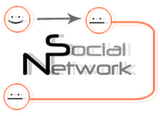
Social Network App Download Page
Contents
Brief Description
The Social Network Cytoscape app creates a visual summary of how individuals are connected. Biological networks can be visualized and analyzed using Cytoscape. Often researchers want to go beyond the network of proteins or genes and also look at the inter-connectedness between colleagues and institutions. Who tends to publish together? What institutions are most collaborative? Are there inter-disciplinary connections in my institution? The app addresses these questions by building co-publication networks where the nodes represent authors, edges represent co-authorship and edge thickness represents how frequently co-authors collaborate.
Installation
The Social Network App only runs on the latest version of Cytoscape (Cytoscape 3.x). Instructions for downloading and installing Cytoscape 3.x can be found HERE.
Once Cytoscape 3.x is installed and running:
Download this jar & store it in a local folder: social-network-app-1.0.jar
Go to the menu bar and click on Apps.
Go to App Manager. The App Manager enables you to install the app in one of two ways:
Search: Here you can install the app through the Cytoscape app store. To do this simply search for Social Network App or use a similar descriptive query. A list of relevant apps will be presented to you. Once you've located the app, select it and click Install.
Install from file : Here you can install the app locally. Since the Cytoscape App Store currently doesn't hold the Social Network App this is the option that we will venture to use in this tutorial.
Click Install from File
Locate the locally stored app file (i.e. social-network-app.jar) and select it.
Voila! The app should now be installed.
Launching The App
In Cytoscape 3.x:
Click on Apps
Scroll over to Social Network
Click on View Panel
A new panel called Social Network will pop up on the left side of Cytoscape.
Getting Started
The Social Network App is divided into three main sections (Search, Information, Network):
Search: The Pubmed search section contains three important features:
Search Box: Enter the key-word or query you want to build a network out of here (i.e. an author's last name and first initial).
Search Button: Click this button to commit a search. The app will search for and automatically build a network from the query you entered in the search box.
Search Filter: Filter your searches here. If a broad search doesn't get you want you want, then try filtering it (i.e. instead of searching for authors, search for MeSH terms).
Information Panel: Information panels display extra information specific to each category. The Social Network App currently supports only one information panel (Academia).
Academia: The Academia information panel enables you to build networks out of data files. It currently only supports data files from three sources: (Incites, PubMed and Scopus)
Select Database: Select a database here. There are only three databases available. As stated above, the Social Network App only supports reports generated by Incites, PubMed and Scopus at the moment.
Load File: Provide a path to your data file here. To load a data file, click on the button marked (...). Here are some example files: InCites, PubMed, Scopus,
Specify Network Name: Specify the name of your network here.
Create Network: Once you've provided all the required information (i.e. Load File and Specify Network Name), click here to create your network. If the information you provided is found to be lacking, the app will notify you of this, and offer tips on how to remedy the situation.
Max authors per pub: Specify the maximum number of authors you require in a publication here. Limit is set to 500 by default. This means that publications containing more than 500 authors will not be visualized by the app. Setting the limit to a high value increases the computational demands of the app and is therefore not recommended.
Network Panel: The network panel consists of two sections:
Network Summary Section: In this section, a summary of the network's attributes is provided:
Visual Style Filter: Each specific network has its own set of visual styles. To select a visual style click on the arrows. It is also possible to create your very own visual styles. To create visual styles from scratch, click on the VizMapper tab in the Control Panel. For a tutorial on how to use Cytoscape 3.x's VizMapper click HERE.
User Guide
Development
Setting up Eclipse (or other IDE) for development of the app
Examples
